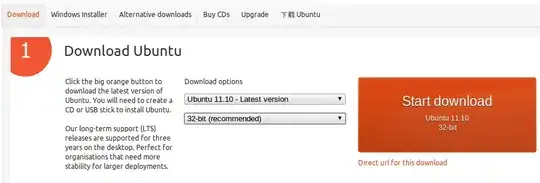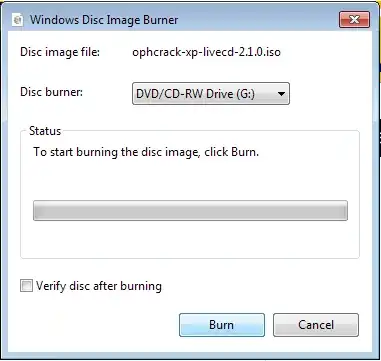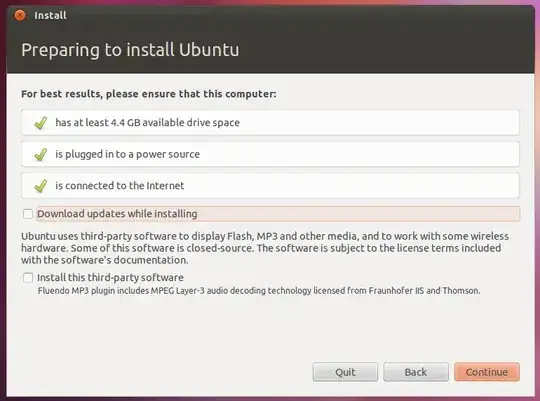Solution:
Two options here
- Install Ubuntu in a HDD with another Operative System.
- Install Ubuntu in a HDD which have data.
1. Install Ubuntu in a HDD with another Operative System:
Start by going to ubuntu.com. On the homepage, scroll down and click the red "Get Ubuntu Now" button.

Under "Ways to get Ubuntu", select "Download and Install".

This will take you to a page where you can choose which version of Ubuntu you want to download and then download it. You need to download the right version of Ubuntu for your computer, 32 bit or 64 bit. 64-bit is much faster then 32-bit if your computer can support it. While in windows, open the Start Menu. Right-click on the word "Computer" and click Properties.

In the window that opens, under the system category, note the "system type". If the type is listed as 32-bit operating system, select the 32-bit option from the dropdown menu on ubuntu.com, then click Start Download. If your system is 64-bit, select the 64-bit option from the dropdown and click "Start Download".

Once the ISO file has finished downloading, open Windows Explorer and find the downloaded file. It should be in your "Downloads" folder unless you chose to save it somewhere else. Once you locate the file, right click on it, click the "Open With..." option and then select "Windows Disc Image Burner".

Make sure you have the right CD burner selected, and that the "Verify Disc After Burning" box is checked. Click burn, go get a cup of coffee, and come back.
Once the disc has finished burning, eject the disc and shutdown the computer. Put the disc into the drive and press the power button. Now, you'll notice that somewhere on the screen displaying your computer manufacturer's logo, usually off in a corner of the screen some text saying which key you need to press to enter additional boot options.
On my computer, which is an HP laptop, it says "ESC Pause Startup". On some computers is F12 or F2 or ESC, etc. and the key you have to press varies from computer to computer. Once you know what key to press, press that key before the computer reaches the "Starting Windows" screen. The screen that you reach will very from computer to computer, in my case the screen looks like this:

Some computers will enter directly into computer setup, some will provide you with an option to boot from the CD or DVD drive without changing settings in the BIOS. The process to get a computer to boot from the CD or DVD drive varies greatly from computer to computer, but is relatively straightforward. Refer to the documentation for your computer on the manufacturer's website if you need any additional assistance.
When you get the computer to successfully boot from the CD containing Ubuntu, you should first get a screen with a stick figure and a keyboard. Press any key at this point to change the installer language, otherwise, to leave it to the default English, don't press anything. After that for several minutes, depending on the speed of your CD/DVD drive and of your computer, you should see a screen like this:

Be patient while the computer loads Ubuntu from the CD. When the loading has completed, you should arrive at a screen similar to the one below:

Once this screen has loaded, click "Install Ubuntu". The next screen:

Be sure that all the requirements are met. If you need to connect through Wi-Fi because you want to be able to download updates during the installer, saving you the need to update afterwards, then use the Wifi Menu in the top left corner of the screen.
In the next screen, you can select weather or not you want to dual boot, since you do, select "Install Ubuntu alongside Windows 7". Click Forward.

You can then select how much space you want to devote to Ubuntu by clicking and draging the separator. When done, click "Install Now".

The rest of the installer is very self explanatory. It will guide you through naming your computer and creating a new user account, as well as giving you the option to import settings and files from your windows account. Have fun with your new Ubuntu installation!
2. Install Ubuntu in a HDD which have data:
Want to keep all your data?:
You should install Ubuntu on a separate partition. The most important thing is you should create a separate partition for Ubuntu manually, and you should select it while installing Ubuntu.
First create a separate partition for Ubuntu while running Windows (like a partition with more than 10 GB). Also create a small partition for the swap partition (size is equal to your RAM size).
- You should know the partition sizes you created so that you can identify them easily while installing Ubuntu.
See the below images - I picked them by googling so they won't be same as yours (like partition sizes and number of partitions).
The second important thing is while installing Ubuntu select "Something else".

It will allow you to select your manually created partition to install Ubuntu onto it.
Now select and edit the partition you created for Ubuntu. Be careful in selecting. Check twice that you selected the correct partition, not some other partition as you may lose data like before.

Select the format partition, use as mount point as shown in the image. The size is up to you.
After that, select the swap partition, and edit it as shown in the image (size is your choice).

After that select the "Device for boot loader installation" at the bottom and select the one with /dev/sda at the beginning.

Now you can select "install now" at the right bottom.
Information taken from answers here and here.















sudo apt-get install gparted. Run gparted do appropriate partitions. – William Mar 01 '15 at 04:56